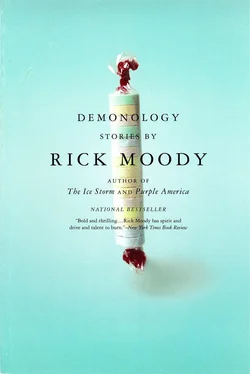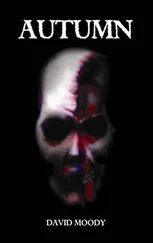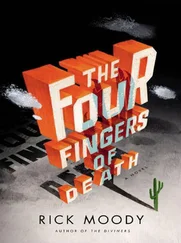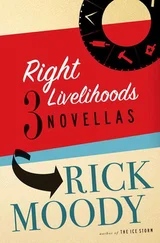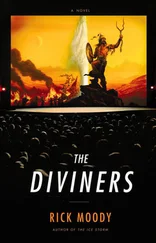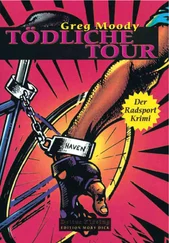$900
18. Moody, Rick. Garden State: A Novel. Wainscott, NY: Pushcart Press, 1992. Hard-to-find hardcover edition. Signed.
$325
19. Olafson, Olaf. Um Yceghrönte då Kzæpøqubnïòõs-ghemen der VhäYçhnachtÿshesse! Ostuni, Italia: Editore Zanare, 1921. Arguably Olafson’s towering achievement, certainly one of the most compelling of early twentieth-century philosophical works, this argument dates from the years after the author was shipped from Oxford directly to Broadmoor, where he was compelled, in his madness, to address the indeterminacy of, indeed, the total inability to prove the existence of any other, of any love, of any parent, of any pet, of any friendly acquaintance met in passing at a coffee shop, anyone. The work is based of course on a brain-in-a-vat hypothesis that came to Olafson as delusional inmate, at which time he suffered with a hysterical cessation of all sensory data; not eyes, nor ears, nor taste buds, nor olfactory receptors, nor even the surface of Olafson’s skin would receive data. He was left entirely alone without intellection. This work, then, is a repudiation of all that comes to us from Descartes’s cogito ergo sum and from the positivists who still cast a long shadow on Olafson while he was pursuing his studies in England. So profound, so uncompromising is Olafson’s nihilism that he might have prevented this work ever coming to light (of what value is publication if you don’t believe that any reader exists?), were it not for his brother Hans, who in 1920 took the author to southern Italy, to a region of olive trees, the luscious teal of the Adriatic, La Città Bianca, the narrow streets and medieval basilicas, the whitewashed alleys, dating all the way back to the occupation of the Masapians from distant Croatia (they ritually consumed their young). In these austere yet strangely celebratory streets, young Hans, desperately morose, sat with his brother Olaf (drooling, incoherent) at a table outside a local cafe and ordered for him uno cona di gelato pistacchio. Whereupon a great light, like that which brightened Theresa in her ecstasy, enlightened him and he could see and he could hear the music coming from the basilica, there were women in their shawls, there were dogs in the piazza scratching their fleas and sidling up to the turisti for food, there were carts and horses and fresh cherries and this fabulous gelato, and thus were born for Olafson the twin discourses of all his philosophy, negation and recreation.
$2,500
Translated by a Goddess
20. Pizzicato, Sergio. (Anna Feldman, trans.) Illusionism in Mannerist Painting and Since. Chicago: University of Chicago Press, 1991. By mannerist, Pizzicato referred, of course, to the period after the great paintings of the Renaissance, when what was so routine, the masterpiece, gave way instead to frescoes and canvases that while delightful seem suddenly to reflect not the perfection of human imagination, but rather its imperfections, its artifices, its dodges and feints. Pizzicato suggested this illusionism in his own sleights of hand, by addressing forgeries as though these were genuine paintings of the period, by footnoting texts that didn’t exist, by creating fraudulent citations for his bibliography. He was discredited at the università in Rome. He was then arrested, as the story is recreated, by the polizie at the Pantheon itself, while listening to a group of American teenagers singing madrigals, while afternoon sun streamed in through the opening in the ceiling, while he ate from a bag of french fries purchased just up the block at a McDonald’s franchise. The charge, of which he was entirely guilty, involved incorporating into his work uncited quotations from the early poetical works of Pope John Paul II. After serving out his incarceration, he left Italy altogether for Ireland, of all places, where his monumental interpretation began contextually to appear as what it was, the most creative of all Italian postwar works of fiction. But this is all beside the point. If Pizzicato’s contention is that the illusionism of mannerism is more realistic than the realism of the Renaissance, if artifice — magnificent, playful, salacious, decadent, sullen — is more real than the studies from cadavers of Leonardo and Michelangelo, then what of Pizzicato himself? Can we really be sure there is a Pizzicato? And if Pizzicato is himself, say, a bank teller from Phoenix, or an incredibly bored naval cadet (on six months of submarine duty), or a dealer in rare books and manuscripts, what of his translator? Her early work, as I have already pointed out, was in Pre-Columbian forgeries, and so why the sudden interest in Italian painting, in the period after Italian painting was any good? Was it a crisis in her personal life? Was she heartbroken because of the defection of a lover? Had a beautiful young bibliographer of the greatest of expectations been suddenly sundered from her by the constabulary forces of Back Bay, who mistook his constant serenading at her window, his ritualistic garbage-can rifling, his worship of her utility bills and postcards for a derangement? Was it possible that she realized that all of her life’s ambitions were just elaborate put-ons, that no author, no hack, no unpublished scrivener, was anything but an articulation of God’s devotion to his own rich creative energies, just a mutable symbol, therefore, a little placeholder? Was this the truth of Sergio Pizzicato, and thus of Anna Feldman herself (and me, too, if we’re being con sistent)? Thus Pizzicato’s inscription on an English translation must be spurious. Nevertheless, I price it as though it were real: Pizzicato, hit etnunc, 4.1.1992.
$1,500
21. Straw, Syd (Harris, Susan). The John Cage Story. New York: De Capo, 1999. First novel by the singer/songwriter and former lead vocalist for NYC’s Golden Palominos. Not a story of John Cage, the composer, in the conventional sense at all, but rather the story of Straw’s thirteen months caring for her ailing father (song-and-dance man Jack Straw) as he relinquished himself to lung cancer. What’s reliable in the fluxus of grief? Nothing, and the twittering of birds, the wind chimes on the snowed-in porch, the sound of a leak in the basement, the notations for her own wordless canticles at her father’s bedside nonetheless suggest the inadvertent beauty that was so essential to Cage’s work. Those of us who have now outlasted our own parents will find this a worthy investment at an attractive price. This reading copy signed, in a fascinating association, for short story writer Amy Hempel, author of the influential Reasons to Live and Tumble Home: Thanks for the week at the beach, you are my idol, love Syd.
$350
By Jerome David Salinger
22. Salinger, J. D. The Diamond Sutra: A Cookbook. Unpublished manuscript, typed on a Royal, from the late sixties or early seventies. Mimeographed, not photocopied. Contains no mention of the Glass family, but does meditate at length on vegetarianism, Taoism, baseball, and the electric period of Miles Davis. Includes some mournful anti-war poems that are quite moving. Signed by the writer to a friend, Tom, rare as such.
$30,000
23. Vidal, Gore. The Diagnosis of Collectors. Providence: Burning Deck, 1983. The title here alludes to the pathology of collection, and not only that pathology of book collectors, clearly the most disturbed of the breed, but also to hoarders of antiques, of miniatures, ceramic bears, Star Wars paraphernalia, Kiss action figures, early video games, Gidget novels, Jell-0 molds, LPs of progressive rock acts of the seventies, garments worn by Elvis Presley, and so forth. Vidal, the author among other things of a masterpiece entitled Myra Breckinridge, correctly posits collecting as a pathology of the amorous in a Capitalist economy; it is things that make us happy when conversation begins to reveal itself as a paltry substitute. I loved words when people were nowhere on the horizon and having begun to have a taste for them, for all that was summoned by words in my skull — a wealth of imaginary comforts — the world with its people seemed but a discount substitute, Anna Feldman with blond bob has goslings now, trailing after her on the beach at Nantucket, no doubt, where the sun this week is bright and plovers scatter at her feet. Little Dee Dee and Marie and Liza, each carries a stick with a length of kelp spiraling around it; each makes hearts in the sand, writes names; am I the bad guy from some videotape that Anna puts on in the living room so that she might kiss her husband, the tax lawyer, before repairing to the garage to call her lover on a cellular phone, her lover never to be possessed but in motels and hotels, and in her imagination; who has conceived of whom, Anna or her collector, and from which book did they get the idea?
Читать дальше
